Vegetable IPM Report 8-21-13 – Click to View | Download | Print
Current Week’s Pest Maps – Available Maps for the week are highlighted
- European Corn Borer Map
- Corn Earworm Blacklight Map
- Corn Earworm Pheromone Map
- Brown Marmorated Stinkbug Map
- Vegetable IPM Pest Map Archive

